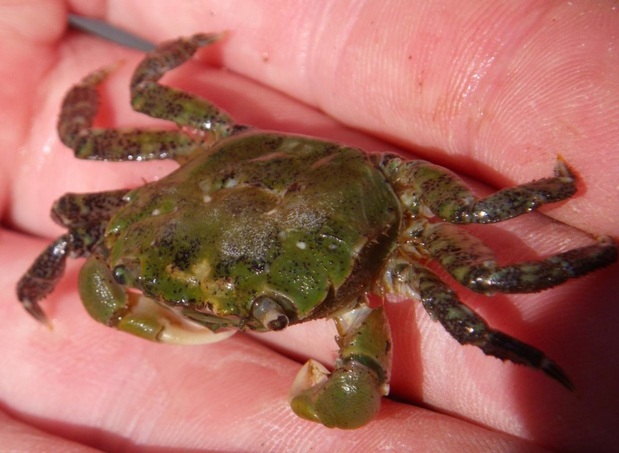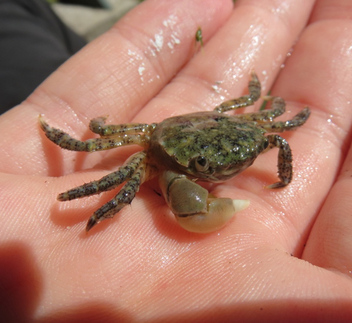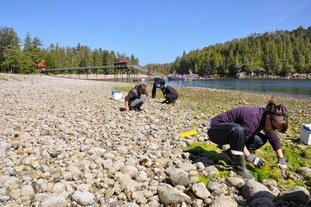Hairy shore crab, yellow shore crab, mud-flat crab, Oregon shore crab, green shore crab • Hemigrapsus oregonensis
Identification
The hairy or yellow shore crab is a small crab, reaching 5 cm across. It can be varying shades of grey to yellow or dark green, with white-tipped pincers. It gets its common name from the setae that cover its legs, giving it hairy legs. The front of the carapace has three teeth. Click here for more photos of this species.
Habitat & Range
The hairy shore crab is found under rocks, like those pictured above, in the intertidal zone. It is also found on shorelines with finer sediment and/or more plant matter, including open mud flats and sand beaches, eelgrass beds, and estuaries. It ranges from Alaska to Baja California, Mexico and is abundant throughout this range.
Similar Species
The purple shore crab (Hemigrapsus nudus) is quite similar to the hairy shore crab, but it has few to no hairs on its legs. The purple shore crab is often purple, but can also be shades of olive green, making colour an unreliable identification feature for any small greenish coloured shore crabs found in the intertidal. The purple shore crab usually has dark spots on its claws that the hairy shore crab lacks, but again this is not the most reliable feature as the spots are not present on all green variants.
Intriguing Info
Hairy shore crabs, like many other crabs, can be identified as male or female by their abdomen structure. Males have an 'Eiffel tower' shape, while females have more of a 'beehive'. The female's rounded abdominal flap can carry more than 10,000 eggs at once. Egg-carrying females may be seen from January to mid-July.
The hairy or yellow shore crab is a small crab, reaching 5 cm across. It can be varying shades of grey to yellow or dark green, with white-tipped pincers. It gets its common name from the setae that cover its legs, giving it hairy legs. The front of the carapace has three teeth. Click here for more photos of this species.
Habitat & Range
The hairy shore crab is found under rocks, like those pictured above, in the intertidal zone. It is also found on shorelines with finer sediment and/or more plant matter, including open mud flats and sand beaches, eelgrass beds, and estuaries. It ranges from Alaska to Baja California, Mexico and is abundant throughout this range.
Similar Species
The purple shore crab (Hemigrapsus nudus) is quite similar to the hairy shore crab, but it has few to no hairs on its legs. The purple shore crab is often purple, but can also be shades of olive green, making colour an unreliable identification feature for any small greenish coloured shore crabs found in the intertidal. The purple shore crab usually has dark spots on its claws that the hairy shore crab lacks, but again this is not the most reliable feature as the spots are not present on all green variants.
Intriguing Info
Hairy shore crabs, like many other crabs, can be identified as male or female by their abdomen structure. Males have an 'Eiffel tower' shape, while females have more of a 'beehive'. The female's rounded abdominal flap can carry more than 10,000 eggs at once. Egg-carrying females may be seen from January to mid-July.
References
Carefoot, T. Learn About Crabs & Relatives: Reproduction. A Snail's Odyssey. Accessed 11/01/2016.
Harbo, R. M. (1999). Whelks to whales: Coastal marine life of the Pacific Northweest. Madeira Park, BC: Harbour Publishing. P. 75.
Cowles, D. (2005). Hemigrapsus oregonensis (Dana, 1851). Invertebrates of the Salish Sea. Rosario Beach Marine Laboratory. Accessed 20/04/2013.
Authors and editors of page
Chanda Brietzke, Kelly Fretwell, and Brian Starzomski (2016).
Carefoot, T. Learn About Crabs & Relatives: Reproduction. A Snail's Odyssey. Accessed 11/01/2016.
Harbo, R. M. (1999). Whelks to whales: Coastal marine life of the Pacific Northweest. Madeira Park, BC: Harbour Publishing. P. 75.
Cowles, D. (2005). Hemigrapsus oregonensis (Dana, 1851). Invertebrates of the Salish Sea. Rosario Beach Marine Laboratory. Accessed 20/04/2013.
Authors and editors of page
Chanda Brietzke, Kelly Fretwell, and Brian Starzomski (2016).






